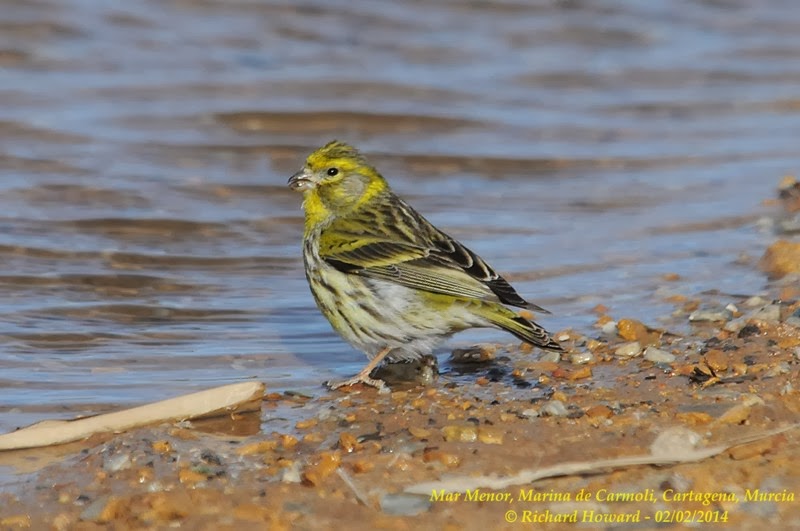I'm writing this not because of any great sighting or sightings, but because it's a cold, very windy, cloudy day here, so with nothing better to do, I thought I'd let you all know what's (not) being seen locally.
The local salinas seem to be VERY quiet - although I've not been there in the last week or so, people have told me that there's nothing to be seen at the salinas of San Pedro del Pinatar.
Local to me, numbers of Audouin's Gulls are building up nicely at the salinas de Rasall in Calblanque and there are still al three species of the common 'shanks there (Redshank, Greenshank and Spotted Redshank), but little else.
Gulls at the salinas at Rasall, Calblanque
At the sailing club at Los Urrutias, the Great White Egret is still putting in the occasional appearance, and there are still up to 6 Greater Flamingos there, together with a few Black-headed Gulls and Sandwich Terns, and the single Avocet that seems to have taken up residence there.
The Avocet that seems to have taken up residence at the sailing club, Los Urrutias
A pale morph Booted Eagle that floated over while I was there
In other parts of the Mar Menor (west of Los Urrutias), the large numbers of Great Crested Grebes and Black-necked Grebes have disappeared, together with all the Mergansers. That's not to say that they can't be seen, just that instead of seeing them in their hundreds, Great Crests are down to a few birds, and the Black-necked's down to a few tens of birds, and I haven't seen a Merganser for a few weeks now. That should all change soon, as towards the end of February, the return passage is normally in full swing for these birds, and on a windless afternoon from the 'desembocadura de la rambla de Albujon' it is quite often possible to see hundreds of Great Crested Grebes together, plus sometimes a few Red-breasted Mergansers (and if my theory is right, hopefully a Goosander in amongst the Great Crests - if they've come down south past us in November, they've got to go back north past us at some stage!).
The other day a friend of mine Juan Capel, wandering around the 'marina de Carmoli', came across and photographed an adult female Pallid Harrier - an excellent record and only about the 7th for the region of Murcia - his photo can be seen on the following link:
http://i1172.photobucket.com/albums/r570/kpmartinezja/2014-01-2918652_zps3eca310f.jpg
So the following afternoon I spent the afternoon wandering all over the area. Nothing of his bird, but I did see a few Booted Eagles, Common Buzzard and Marsh Harriers. I decided to stay until it got dark, looking over the 'marina de Carmoli' from the small asphalted football pitch there, and I was there from 5pm till dusk. There was quite a movement of Marsh Harriers with up to 7 in the air together, with up to 3 adult male birds, but it all happened once the sun went down. Counting the birds I could see roosting, and the birds in the air, I had a total of 13 Marsh Harriers, and then just after sunset, two ringtail harriers - one a Hen Harrier and the other a smaller, more pointed winged Pallid Harrier! Success!
We had our monthly 'marine' count from Cabo de Palos on Saturday, which produced a steady flow of Gannets (mainly adults) south, 6 Great Skuas (with 4 together sitting on the water) and 4 Razorbills south, plus another steady stream of Balearic Shearwaters north over the whole 2 hour period that I was there. Plus a few Audouin's Gulls flying in, and a few Shags in the water around the rocks close in.
On sunday morning, I had a look at the Mar Menor again in the hope that there may be some scoter around. No luck, but as it was a sunny day, and there was a large puddle in the parking area, I sat for an hour to see what might come down to drink, and took a few photos.
Chatting in the parking area, this Grey Heron came past, being chased by Yellow-legged Gulls
On the other side of the road, these Curlew got up from the fields
Sat in the car in the parking area next to a large puddle, the birds that came down to drink - Serins...
... Water Pipit ...
... male Serin ...
... Reed Bunting ...
... male Stonechat ...
... more Serins ...
... and another male Stonechat
All the birds disappeared when this dark morph Booted Eagle came over
but eventually they came back - here a Greenfinch ...
... and still more Serins
And keeping an eye out over the area, a Southern Grey Shrike
The group of five Ferruginous Ducks
And with them, a Black-necked Grebe
And that's about it for now.
Ciauu





















Looking good considering your 'bad' weather ..
ReplyDeleteThe relentless rain and wind here is really getting on my wick!!
I'm flying out on the 17th for a short stay with my son in tow.
I fancy looking around the lake at Torremendo as it is close by. Is there anything there worth looking out for?
Hi! As I said in my post, things are pretty quiet at the moment (but may be due to lack of people going out to look). At the lake you talk about, there's always the possibility of Common Crane and Osprey which would be worthwhile keeping an eye out for, but other than that, I can't say I've heard of anything. Generally in Spain, all the action seems to be on the coast at the moment but mainly northern Spain that's being attacked by all these storms, and bringing in numbers of Glaucous & Iceland Gulls, plus Ross's and American Herring Gulls.
Delete